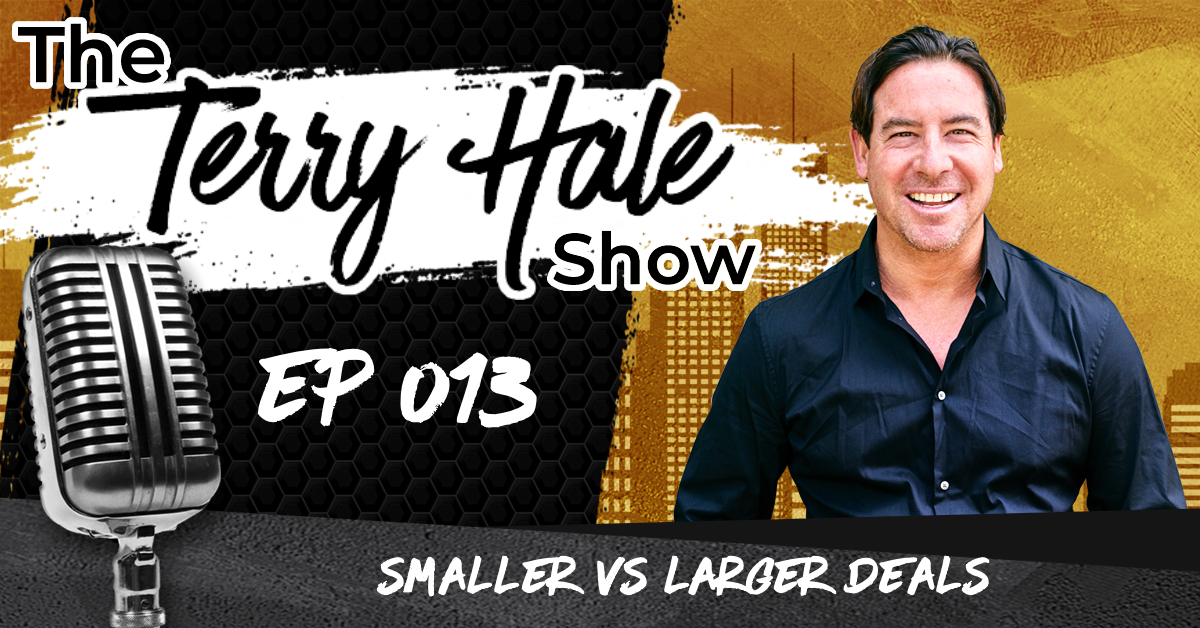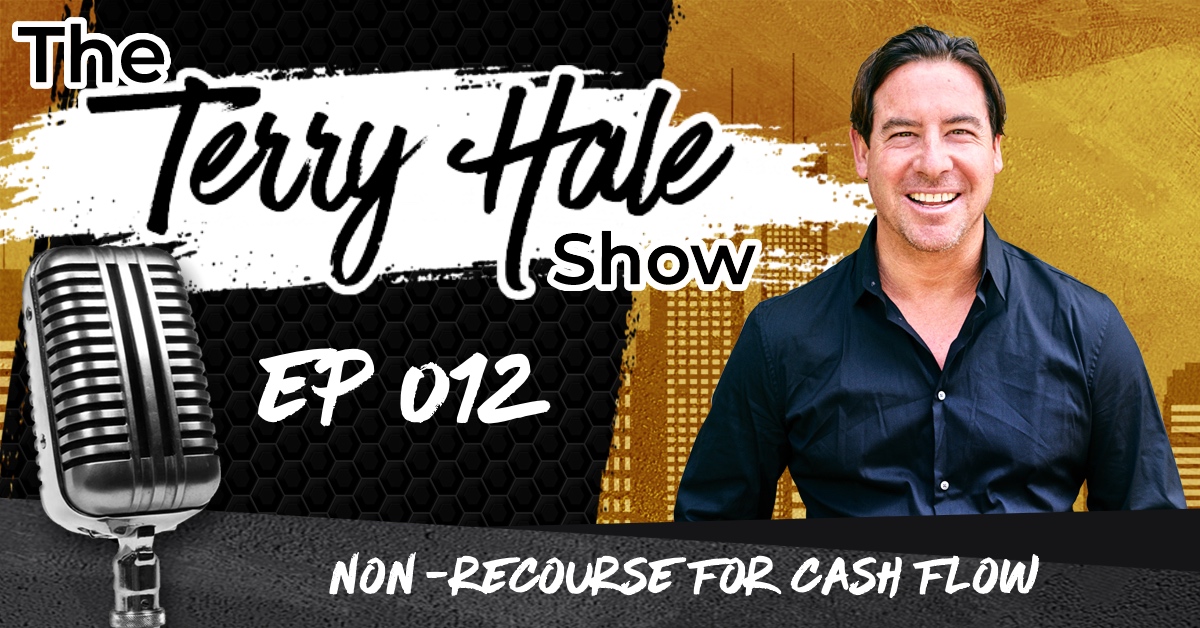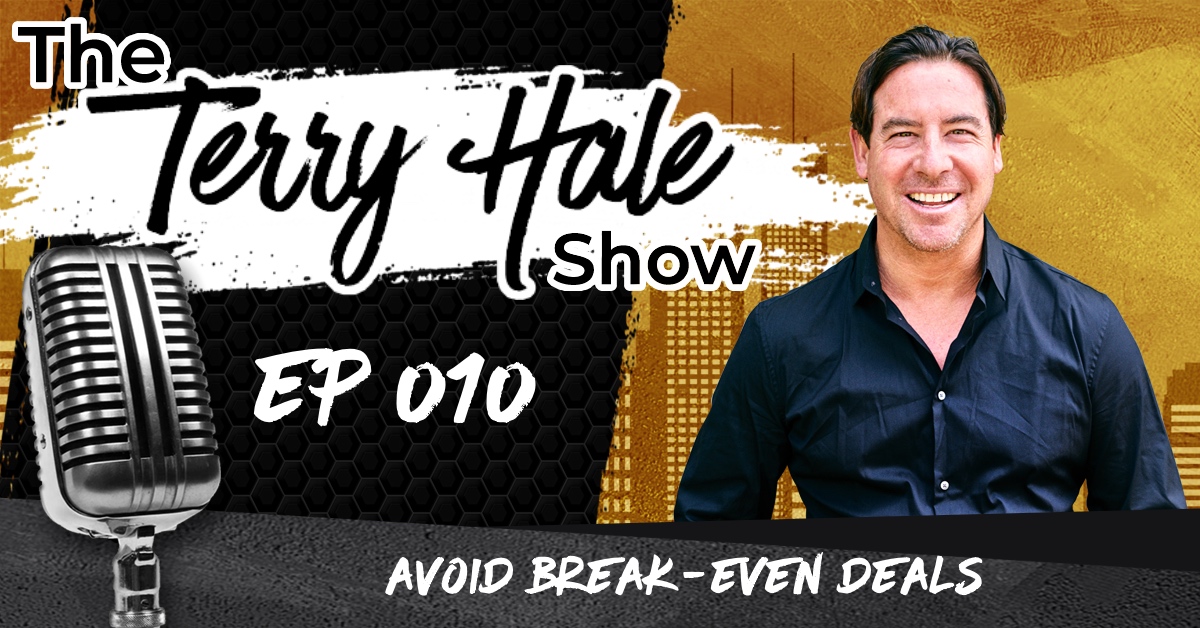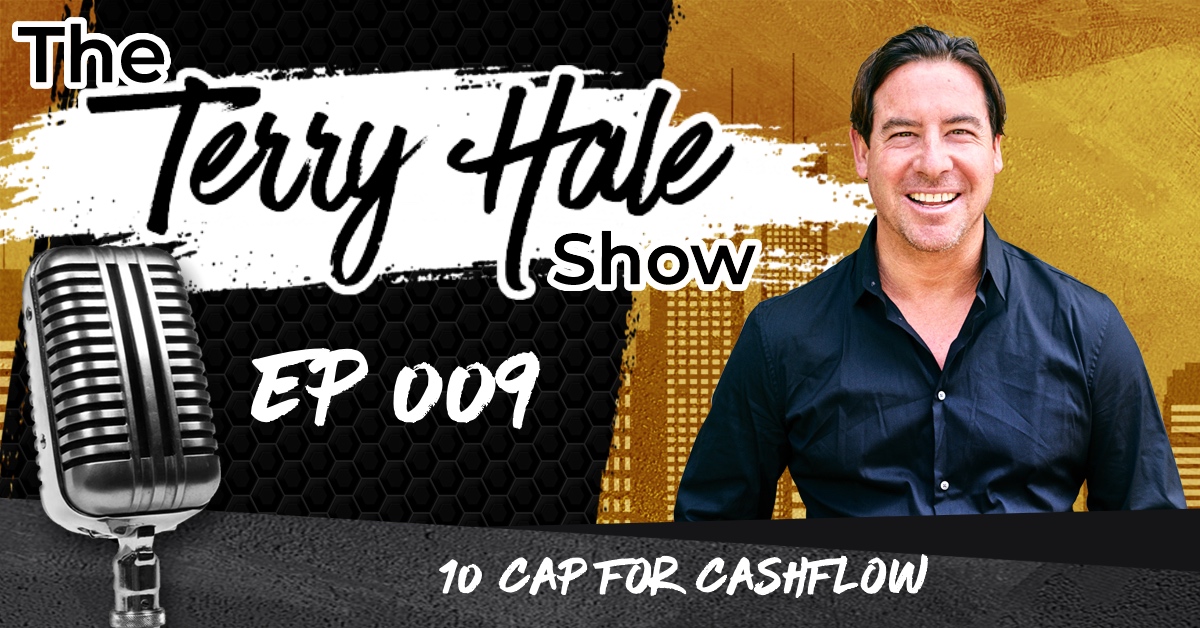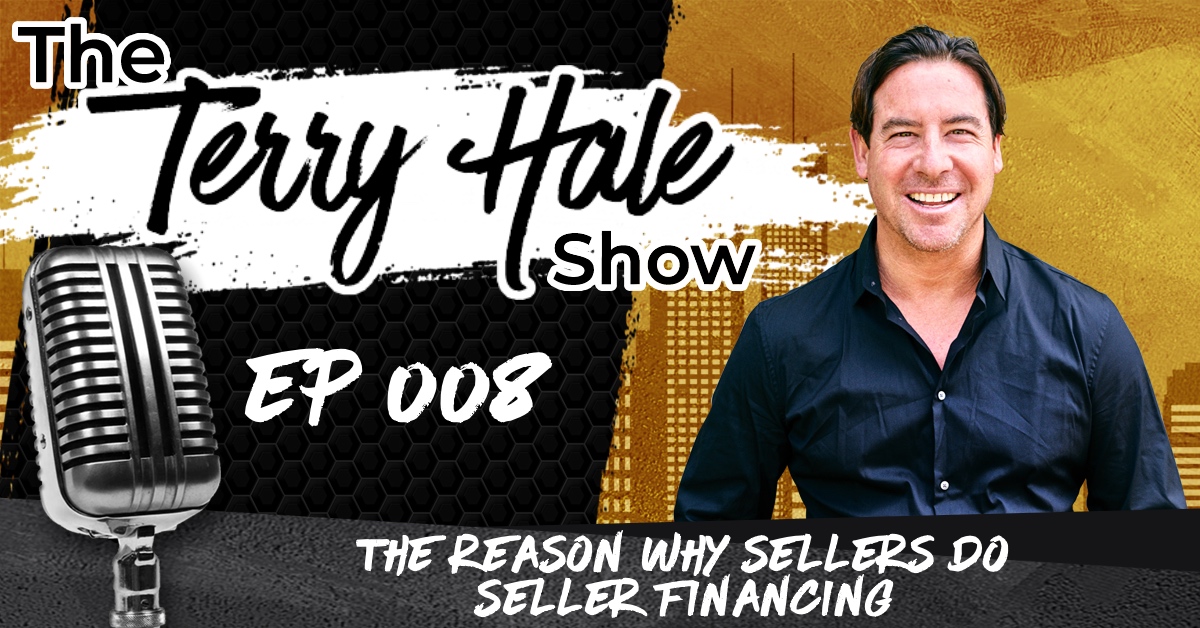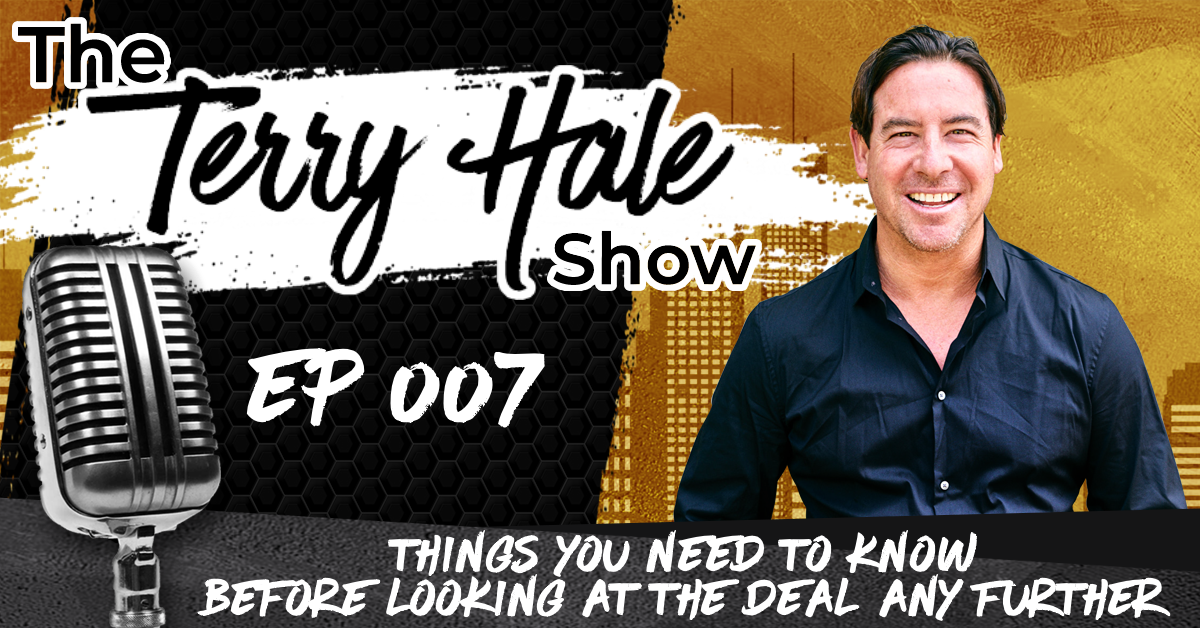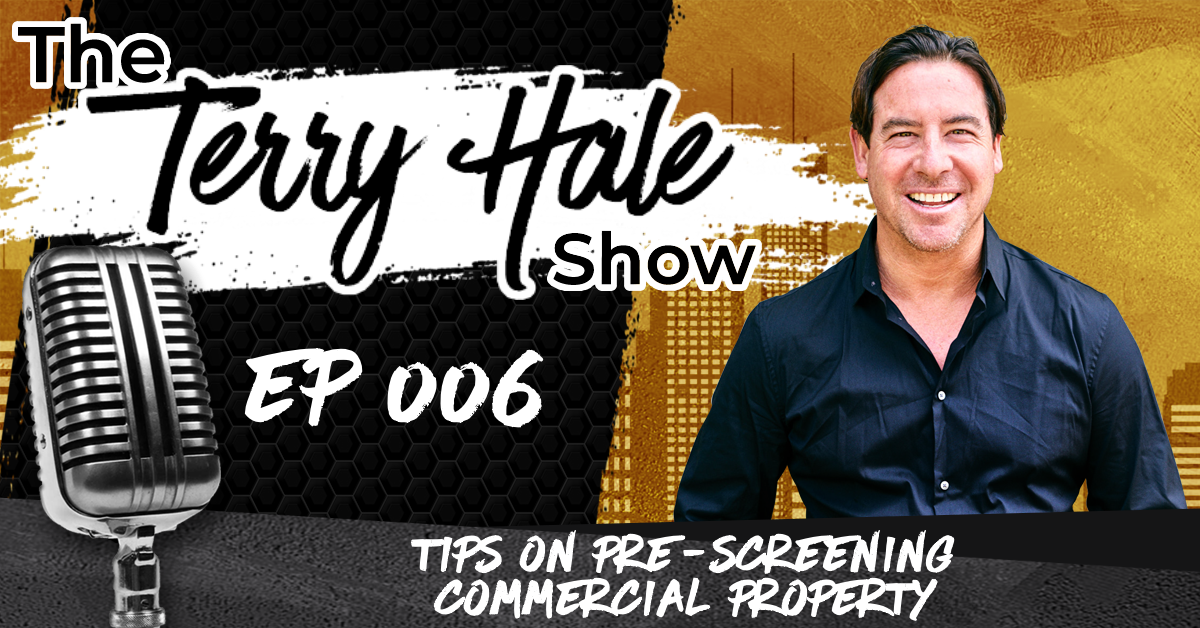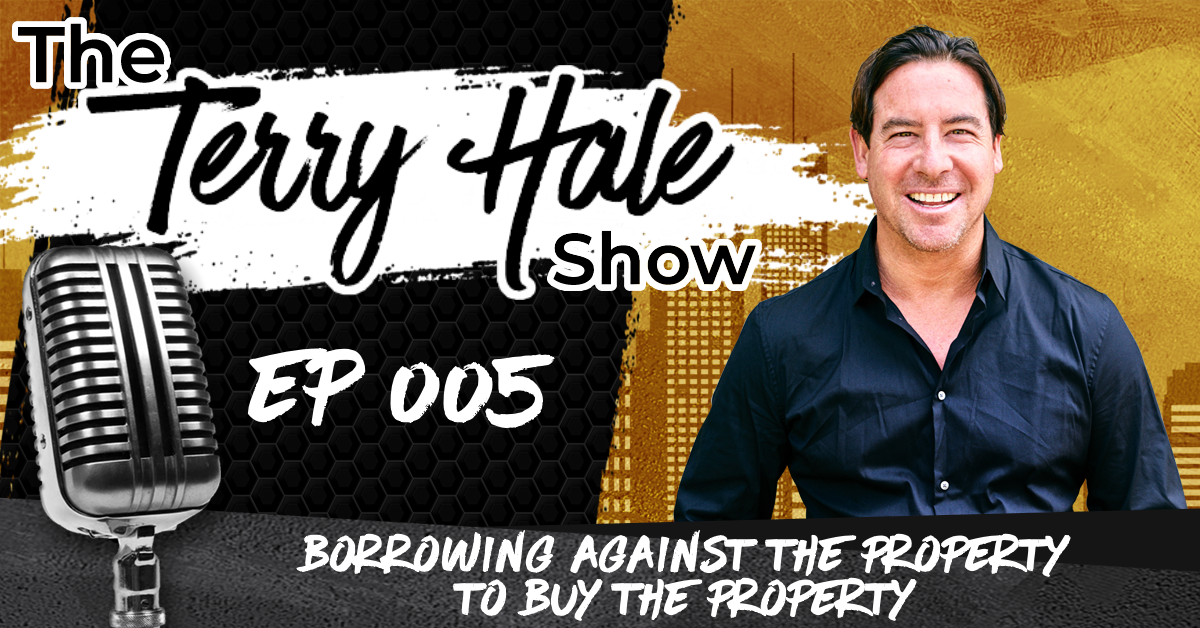Posts by Richard Matthews
The Terry Hale Show Episode 14
Strategy of a New Deal Closed
TRANSCRIPTION
Hey, this is Terry Hale.
I wanted to share some details of a project
that I just closed with a client of mine.
The client has been with me for two and a half months now.
And he located a project in Kissimmee, Florida.
It’s a self-storage facility,
a little over 100 units, some parking spaces.
But the deal…it was kind of out of the norm.
It was 100% full already.
And I typically look for value-add from vacancy.
So vacancy is, the quickest way to take a property
and realize upside that raising rents,
adding profit centers, lowering taxes by protesting them,
and also lowering expenses – any vendor expenses.
But with all that said… this project,
the reason why it was so great,
is we saw it advertised at 1.2 million.
And it was an inflated value
it sat on the market for a while eventually fell out.
And my client noted something
that I just previously taught a couple of weeks
before he found the project.
And this is what I taught. This is what’s so cool.
What happened was they have a mortgage on the property,
then the existing mortgage,
they were servicing debt at a high-interest rate.
And so they factored in their actual
mortgage expense as part of an itemized expense.
That’s not how it works,
you do not calculate your mortgage expense
as part of your actual expense on a property.
And so they did that showing less net operating income.
After we kick that out. As it turns out,
the property is worth a lot more,
I’m talking between that and replacing
the management with the swing gate,
it was definitely a value add of about $70,000 at closing.
So that doesn’t seem like a lot of money,
just $70,000 in income.
But if you were to use a simple calculation,
which is a 10 cap rate,
just taking a 10 cap formula on 70,000,
that will come out to $700,000 in true value.
without adding any additional expense,
we instantly got a value bump, an instant value Bob of 70 grand,
which is a phenomenal opportunity to buy the property.
Plus we also use some negotiation secrets,
which I taught my client
to be able to acquire this property,
we closed it at $500,000.
All cash, quick close after due diligence.
And now we’re sitting on a property
we could easily put back on the market
and make ourselves four to $500,000.
Like that. If you liked this segment,
and understanding some techniques and strategies
of locating properties that are sitting
there all around us that these folks that are selling them,
they just don’t know how to sell they don’t know how to market.
This was just one of those scenarios.
And it’s quite common.
I can show you more go ahead
and click the link in the description of this video
or go to terryhale.com
and watch my free workshop.
Check it out and I look forward
to engaging with you real soon.
Take care
The Terry Hale Show Episode 13
Smaller VS Larger Deals
TRANSCRIPTION
Hey this is Terry Hale.
Want to talk with you about doing smaller
deals versus larger deals and why it’s
so important for you to focus on projects
that are actually going to produce income.
Now, of course, you can start off in this business
and you can do a smaller project. It makes sense.
It’s not big and scary.
It’s an easy project for you to say,
“Hey, you know, what? $300,000.
$500,00. $750,000.” Right?
It’s a smaller price point,
it’s a way to get in to start building a portfolio.
I refer to those as the footprint projects.
A footprint deal – just getting started.
That’s okay.
But you don’t want a continue to just do these
smaller projects, eventually, you want to graduate
and do something that’s got some size,
you want to do something that’s bigger,
that’s going to produce more
actual revenue for you – more cash flow.
I have a lot of clients that come to me, and they’re like,
“Hey, Terry, you know?
I want to make $50,000 a month – cash flow.
Is that possible?”
Yeah, it’s possible.
It’s just not possible continuously doing footprint deals.
It’s kind of like the house buying business,
are you going to become a multi-millionaire
and be worth 10 or $20 million from doing
the house buying business? Chances are…
No. You know, the fact is,
if you’re dealing with larger projects that
are producing income, obviously,
it’s pretty elementary, but you’re going to make more money.
So here’s the secret sauce.
This is where I’d like to see all
of you take things to the next level.
The first thing is to stop looking at just monthly debt service, right?
Don’t look at it as just a monthly number,
because that’ll drive you crazy, it looks risky.
And it quite possibly could look kind of crazy, right?
If you’re saying to yourself, “Wow,
if I get into this project,
I’m going to have to potentially debt service,
you know, $25,000 or $35,000 or $50,000 a month,
and that could look scary.”
But if you understand that income,
net income is on an annual basis, it’s all about a year,
that’s 12 months of actual income.
And then your debt services
also looked at as 12-month actual debt service.
And if you look at things in that fashion,
now you look at your gross,
that’s all the money the project made,
minus the yearly expenses equals your net,
which is your yearly income.
Now, if you look at things like that,
on a year projection on what it’s
truly going to make in the future, all of a sudden,
it doesn’t seem so scary.
The reason why it doesn’t seem scary
is because you’re taking out that one
element of having to do monthly debt service.
And you’re saying yourself, okay,
this is a business.
This is a property, its commercial property.
And everything is looked at over a yearly basis.
And the property has got to produce
enough money to cover its debt service.
And we’re not into breakeven deals,
we’re into actually making money.
So when you’re looking at those types of projects,
look at the projections,
but also understand that the property
has got to carry its debt.
We buy in its “as-is” current condition.
We’re not into breakeven deals,
and we’re looking for future upside.
The upside potential.
So here are the key factors, write this down.
We’re looking for value add from vacancy.
So we’re looking
at a property that’s existing, that looks great,
that’s in great locations, but
it’s suffering from occupancy.
So it’s got low occupancy,
it’s got vacancy, okay?
That’s one. The second thing is low rents.
And the third thing is when the management
is not doing tight collections
and they’re not doing a proper job.
A lot of times what we can do is lower expenses,
sometimes replaced management,
that is a heavy expense,
and all these things add to the bottom line,
and just look for the deals that have all the potential.
Alright, I hope you liked the segment.
If so, go ahead and click the link below.
Check out some more videos or better yet,
just go to terryhale.com
and I look forward to engaging again
with you again real soon.
Take care.
The Terry Hale Show Episode 12
Non-Recourse for Cash Flow
TRANSCRIPTION
Hey, this is Terry Hale.
I just want to take a few minutes here
to talk about NON-RECOURSE LOANS.
What’s so amazing about our NON-RECOURSE STRUCTURE
and how it will benefit you to continue to do even more business
and make even more money.
Part of financing comes down to
typically personally guaranteeing a loan.
That’s called recourse financing.
When you go for recourse financing in commercial real estate,
they’re going to want to see a few different things.
One, they’re gonna want to see your track record.
Two, they’re going to want to see all your assets.
And there’s a reason why they ask for those assets,
which I’ll get to in a minute here.
But another reason that pursuing recourse loans
is not a great thing is something called your “debt to Income Ratio”.
Now, depending on how much income you actually have coming in,
that would support an actual bank.
Meaning, a conventional institutional loan.
If they’re going to go ahead and loan it to you,
or they’re going to say, “No, you get denied”,
you have to have a lot of income to support a lot of debt.
So how can we eliminate that process, you continue to grow,
continue to build your portfolio and continue to build wealth,
it’s called NON-RECOURSE FINANCING.
Now, NON-RECOURSE SELLER FINANCING is amazing.
Regardless if there’s existing debt on the property or no debt at all,
this technique works great. If there’s existing debt,
we wrap the existing seller finance note in first position,
we create a second note in the form of
a NON RECOURSE SELLER FINANCE note.
So what this means is that you’re not going to guarantee the first note,
because it’s already existing on the property.
More than likely, it’s a recourse structure.
That senior debt is secured by the seller,
the seller is going to keep the loan in their name,
create an additional second loan in the form of a seller finance non recourse structure.
So you’re not going to give a personal guarantee,
you’re not going to have your credit checked.
And that means your Debt to Income ratio does not get affected.
The reason why banks want to see exactly your assets,
why they want to know your portfolio,
they want to know about you personally,
is because chances are
they’re going to ask you to do something called
Cross-Collateralization. When you do something like
Cross -Collateralization, what they’re looking for are properties
that are assets that you own,
where you are going to be putting those up,
pledging those as part of the structure to lower the risk of the lender.
What we can do is avoid Cross -Collateralization.
Avoid credit checks, avoid personally guaranteeing notes
and doing a NON-RECOURSE SELLER FINANCED structure.
If you follow this rule, you can continue to do business
you can continue to build wealth without being in harm’s way.
The risky way of doing business is the old way of doing business.
Follow this structure of NON-RECOURSE SELLER FINANCE notes,
get out there, look for value, add plays, create cash flow,
create financial security for your family,
and build something called generational wealth, build that portfolio.
Alright, if you liked this segment,
go ahead and click the link in the description
or visit my website at terryhale.com
and I truly look forward to engaging with you again really soon.
The Terry Hale Show Episode 11
Master Lease Option
TRANSCRIPTION
Hey, this is Terry Hale.
I want to talk with you about this storage facility
that we just closed. It’s a technique that was used
to close this 170-unit Self Storage right outside of Dallas, Texas,
we did this deal with something that’s called
–a technique called–
Master Lease Option.
Super cool.
We got in for not a down payment,
but an actual deposit, we put down the deposit,
we have the seller carry the note for seven years,
the note was carried at 5% interest non-recourse,
no personal credit check at all whatsoever.
And the master lease option gives us two points.
One is we get in as a master tenant with the option to purchase it,
we lock-in a purchase price, this purchase price was less than 900,000
actually came in at $885,000.
We have that seven years to actually pursue this deal.
And to close the option.
properties can be worth a lot more just within a couple of years.
The cool thing about this technique is we got in for very little
only $20,000 down and the seller actually carries
the master lease option note,
we have the right to sublease all these vacancies
for every single vacant unit that we fill,
we actually create passive monthly income,
we’re going to get our deposit back within the first six months or less.
And from that, we’re going to be moving forward
and rapidly filling this thing creating massive cash flow.
There’s a little over seven figures in this deal.
One deal can make you a millionaire _talk about cash flow.
This is where it’s at. All right?
Master Lease Option Technique
wrapped up on the storage facility standing
make well over a million bucks.
Go ahead and check it out.
Click the link in the description to learn more
or visit terryhale.com.
I look forward to engaging with you real soon.
Take care
The Terry Hale Show Episode 10
Avoid Break-Even Deals
TRANSCRIPTION
Hey, this is Terry Hale.
I just wanted to chat with you here real quick
about avoiding the break-even projects.
Who wants to get into a breakeven project?
I mean, think about it, the average person
that gets into commercial real estate,
what they do is they go after bank loans.
So they personally guarantee it, or they’ll cross collateralized.
And they’ll put up other assets that they have equity in
to offset the risk for the bank.
Now, not only that, what happens is they get into it
with 20 to 30% down payment,
that’s a big old chunk of money that they put in the deal,
that money sits in there. And it just accumulates, no interest.
It really doesn’t. I mean, all you’re playing is appreciation,
when you’re getting into these commercial real estate deals
buying with conventional wisdom.
So stay away from the conventional wisdom,
stay away from breakeven deals stay away from
personally guaranteeing loans. I mean, the way to do this business,
if you truly want to be successful and create cash flow,
is to get into deals that are better than breakeven.
How can you get into a deal that’s better than breakeven,
you have to have some way to increase the value.
That’s the upside. We look at two things.
Primarily two. One is the current occupancy.
We want to see projects that are built good locations, rock solid,
no environmental challenges, maybe their mismanagement,
that’s fine, maybe they’re mismanaged, that’s okay.
But we’re looking for the projects that actually have vacancies,
when you have a project that’s built,
a lot of times we can buy these projects,
negotiate these deals less than replacement cost.
Now replacement cost means that if the whole thing
were to fall to the ground, what would it cost to replace it,
that dollar per square foot value of what it’s worth,
we’re buying these properties for less than what it costs to build them,
and they had vacant See, that’s number one.
The second thing is any existing tenants are low rent,
low rent tenants, we can raise the rents as well,
I call that icing on the cake. It’s never a true reason to buy property,
just to buy it and have the exit strategy to raise rents.
But if you take a project that’s got very low occupancy,
raise that and raise the rents, replace management,
a lot of times we can do away with management,
we can automate the process. At that point in time,
once you take away all of these expenses,
what’s happening is you’re increasing the net income and that day,
that net income is your cash flow. That is something that’s so powerful
and stay away from the breakeven deals.
All right, look for cash flow opportunities,
deals that make sense, and deals that have
a tremendous amount of upside and profit.
And you will be cash flowing very quickly,
monthly passive income financial security for your family.
Sounds great, right? It’s an opportunity that’s existing today.
In the right deals if you can locate the right projects.
If you dig this segment, great!
Go ahead and click the link in the description.
Or go to treryhale.com and see some more.
I appreciate it. We’ll get together again real soon. Take care.
To learn more strategies and techniques,
visit terryhale.com or go ahead and click the link
in this video description.
I look forward to engaging with you real soon.
The Terry Hale Show Episode 9
Ten CAP for Cashflow
TRANSCRIPTION
Hey, this is Terry.
I hope all’s well I wanted to touch base
here with you and talk about cash flow.
It’s early in the morning here I just got through dropping my son off.
He’s six years old His name’s Cash. Of course, his name is Cash.
What else would I have named my son?
And it’s a wonderful thing to be able to have continuously engaged,
be actually present and have a business that is around
and supports my family versus me just being so
inundated in business that I forget about my family.
So I drop my son off at school every single morning
unless I’m out of town, of course.
The beautiful thing is it gives me the ability to live my life
and I have to thank cash flow for that.
So let’s talk about cash flow and what that is.
When analyzing a commercial real estate project,
we have our gross income, that’s all the income
at the property makes right?
Then what we have our itemized expenses,
those itemized expenses will list exactly
what the properties expenses are kicking off
referred to as the net income.
Now I use a formula when I look at net income
and my net operating income,
I purchase property. So I have room for you know,
Murphy’s our partners.
So you need room right, we can’t crunch the numbers
down to internal rate of return,
we must understand that we can pencil in the deals,
want to say room for error, but there really is no room for error.
What I’m saying is that we have room to negotiate better terms.
But a good starting point is to purchase property on a 10 cap formula.
That 10 California formula is very basic.
If the property like one we’re working on right now.
It’s got 100 and roughly 110,000 net income.
That property on a 10 cap is worth 1.1 million. Another one
We’re working on it’s a 58-inch chain. So call it 58,000, the 10 cat formula,
the properties were 580,000. If you can purchase with that rule of thumb,
and look at these properties on the 10 cap purchase,
it’s going to help you evaluate these properties very quickly.
Understand that we want to get value to add plays from vacancy,
meaning we can fill them and create upside. And the more units you fill,
the more cash flow we have.
And it’s a beautiful thing to be able to look at these properties quickly
and identify a prospect from a suspect.
As I say, you know, differentiate that, you know,
the deals from the duds understand that we’re looking at
the right projects that have a huge amount of upside.
I like double and even triple value players.
So if I’m going to be getting into a property,
what I like to see is that the seller carries
at least 90% of the paper at a minimum
and we can get in with 10% down plus a few cash reserves
and we can operate the property at its highest and best double our money.
That means that that’s going to be monthly passive income for you
for the rest of your life, or until you saw the project move on to something
a little bigger and better. So remember, cash flow is king.
If you liked this segment, go ahead and click the link in the description,
or visit my site at terryhale.com
and I look forward to engaging with you real soon.
All right, I’m off to the office and then the beach.
Take care. We’ll see you soon. Bye.
To learn more strategies and techniques,
visit terryhale.com or go ahead and click the link in this video description
and I look forward to engaging with you real soon.
The Terry Hale Show Episode 8
The Reason Why Sellers Do Seller Financing
TRANSCRIPTION
Hey, this is Terry Hale here in my office in Malibu, California.
Bright and early in the morning, just finished with my podcast,
and wanted to just take a few minutes and talk to you about
the topic; of discussion and how this all transpired.
So I have a client,
and the client really had to wrap their head around the reasons
why sellers would even consider seller financing,
you know, what’s the give? Like, why would they want to,
you know, carry paper for us, what’s the reason behind that
I’ll walk you around the office as we,
as I do this little segment for you.
So part of the reasons that sellers will carry paper for you
is because of the type of deals that we’re going after,
we’re not going after your average run of the mill type of deal that has,
you know, occupancy at, say 80% or 90%,
the type of deals that we’re moving on our
deals that have very low price occupancy,
but they’re built, they’re in great areas, meaning great locations,
they make sense as far as what their highest
and best use can be, and their cash flow,
add value there by filling the vacancies by raising rents,
adding profit centers,
the deals just make sense. You know, they make sense.
And we’re able to get in on these projects with seller financing,
because we just let the seller know, hey,
there’s no possible chance that this deal is bankable,
you can’t walk into any institution, take out a loan,
be able to qualify for bank financing and be able to get these deals done.
It’s just not what banks do.
They want to cross-collateralized lower their debt,
they don’t want to take on liability, they only want to take on assets,
properties that are already operating at their highest and best use.
So the fact is, we’re able to get in on these types
of projects with seller carry back
and we justify this we say look,
there are only two ways to buy this property.
One is to purchase the property, all cash, we can make it lowball offer.
And we do that all the time it happens we just closed another project,
we tied it up for 395,000. That’s a smaller deal, a little mini storage,
the thing has potential to cash flow
has the potential to be worth closer to 850,000.
And we got that deal for a 10-year seller finance note 4% interest.
And it was a non-recourse structure, no personal guarantee
and that is seller financing ramped up.
And we can do these types of deals over and over again,
rinse and repeat. We don’t have the competition that most people have
when you’re out there buying with the capitalization rate,
looking at these properties, crunching the numbers,
and really just trying to compete against the masses.
We’re in a position where we’re focused on the right deals,
we’re focused on projects with value add again due to vacancy,
and the sellers will carry as long as you can
point out that meant mutual benefit.
That reason why they should carry paper.
The reason why is because two ways to buy it either all cash lowball offer,
or they carry paper to become the bank and they create an income stream.
And we’re able to service that debt by the income from the Property
Plus everything that that property makes
on top of that goes into his National Bank,
meaning cash flow baby.
It’s all about cash flow and you want cash flow.
Now, this is the business to do it. Stop flipping houses,
stop looking at other ideas of pursuing ways to make money.
This is the vehicle that can produce
massive amounts of wealth for you.
Just look at projects that make sense
and do the right deals that yield
amazing returns on your investment.
And the beautiful thing is,
you can borrow other people’s money to do it.
And you don’t need your own personal credit
if you structure the deal the right way.
If you liked this segment, go ahead
and click the link below in the description
and visit terryhale.com
and remember it’s all about cash flow.
CRE commercial real estate is the
vehicle that produces massive wealth.
I look forward to speaking with you real soon. Take care
The Terry Hale Show Episode 7
5 Things You Need to Know Before Looking at the Deal Any Further
TRANSCRIPTION
Hey, this is Terry Hale commercial real estate trainer,
want to get with you here
and teach you something that is so very important.
I know that a lot of you have been looking around
for commercial projects,
taking your time; time is money.
If you’re out there and you’re looking for projects,
and you haven’t found anything yet,
it’s maybe because you’re looking at
the deal and dissecting it prematurely.
There are five things that you need to know
five things before you want to ever take your time.
And look at the deal any further.
Alright, so let’s go through the five things.
Number one is the asking price,
not what they listed at; what their bottom line is;
what they’re truly willing to take; what’s the realistic price point.
All right, that’s number one.
Number two is going to be the as-is value, what it’s worth today,
apples to apples to other comparable sales,
to current market rents to replacement value if it’s vacant,
meaning what it will take to rebuild it. What it’s truly worth as is today.
All right, we use the net operating income formula
To be able to determine what the true value is,
it’s all about the current net, not the gross, right.
The third thing is the after repaired value; after developing value,
meaning after you fill it, whatever you plan to do to it,
what it’s going to be worth in the future is important to make sure
that there’s enough meat on the bone.
So you can create that monthly passive income for that huge
windfall of capital to change your life.
All right, the fourth thing is going to be repairs.
Is it a huge repair job? Is it going to be new roofs?
Is it going to be, you know,
repainting a whole parking lot for multifamily?
What is the repair cost?
Is that how you’re realizing your upside is just for repairs?
Because if you’re going to be paying
an extra half a million dollars in repairs,
and you buy a property for, say, a half a million bucks,
you’re not really buying it for half a million.
You’re really putting a million dollars in the game there to realize
whatever the future value is,
so make sure that you understand your repairs.
Last thing is the current loan amount. How much do they owe?
You see, it’s important that
Understand what they owe on the property
because if you’re asking for using my techniques, seller financing,
and you want to get a five-year deal,
but their senior debt existing debt balloons in, say two years,
well, you’re doing the wrong negotiation,
you’re negotiating prematurely.
And obviously, they’re going to say no
and you don’t even know why.
So make sure you get the information first,
the five things that you need to know
before you want to determine anything else.
Alright, I hope you enjoyed this little segment here.
If you dig it, check out below.
Go ahead and look for the link. Look at the comments section.
Click it and I look forward to engaging with you again. Take care
The Terry Hale Show Episode 6
Tips on Pre-Screening Commercial Property
TRANSCRIPTION
Hey, this is Terry Hale,
commercial real estate trainer.
I want to give you a few tips on
prescreening commercial property.
This goes for all property types,
regardless of the one
that you’re interested in.
These tactics and strategies I’ve been
using for close to two decades.
First thing I wanna teach you here
is the capitalization rate formula.
It’s important because if you
buy too low of a cap rate,
you’re gonna be paying retail,
or you’re gonna be buying into what
I refer to as hope or speculation,
or the projection of future value,
meaning you’re gonna have to
wait a long time to make money.
If you wanna make money right away,
you wanna make money now, then you need to
be able to structure
the deal, and the terms,
and buy the property for the right price.
So here it is.
This is the cap rate formula.
You got your gross income,
that’s everything that the property makes.
You got your itemized expenses.
And then you end up with your net.
That’s your net operating income.
You take the NOI, you divide
it by the purchase price.
It equals either a single
or double digit number.
That’s referred to as
your capitalization rate.
That’s the “cap rate”, alright?
So we’re buying on a 10 cap formula.
10 cap formula, if the properties
pulling in $53,000 NOI,
you just add zeros.
It’s worth $530,000 on its end cap.
It pulls in $68,000 NOI,
it’s worth $680,000.
So forth, and so on.
See the simplistic nature to
this type of prescreening metric?
I’ve been using it for a long time,
building wealth for my clients.
Building financial security
for you and your family.
That’s what it’s about, okay?
A couple of other key identifiers.
We’re looking for, low
occupancy, a high vacancy.
The boxes are already built,
you don’t have to spend
money finishing ’em off,
doing rehab, doing additional
property expansion,
building anything. They’re already built.
All you do is fill the boxes.
Also, low rents.
When the rents haven’t
been raised in forever,
they’re not even at market
rents, we can do a nuisance rent,
for instance on self-storage,
couple hundred units across the board.
We raise it just five dollars each,
the NOI goes up tremendously.
You make money right away.
And that’s what it’s about,
making money right away.
So I hope you enjoyed this
little pre-screening video
and if you dig it, cool, look below.
Look for the link, click it.
I look forward to engaging
with you some more.
All right?
Take care and we’ll talk real soon.
The Terry Hale Show Episode 5
Borrowing Against the Property to Buy the Property
TRANSCRIPTION
Hey this is Terry Hale,
commercial real estate trainer.
I had just finished
this awesome negotiation
and I wanted to talk about
the strategy that I used
to be able to get in on this deal
and borrow against the
property, to buy the property.
Alright, so it’s an advanced tactic,
but I’ve been using these tactics
and they’ve been done in big
corporations for a long time
to buy businesses as well.
And I wanna share it with
you, on a smaller scale
of what I do.
So of course, I purchase all
types of commercial property.
This one happens to be
a multifamily, 42-unit,
and the property had some
vacancy so there was an upside,
which is great.
But here’s the strategy that I used.
It’s called a subordination tactic.
What I did, was I created
a seller financed note
on the property because it
was owned free and clear,
meaning no debt-encumbered
on the property whatsoever.
I created a seller-financed note,
minus 20% of the purchase
price, so I put some skin
in the game, 20%, and I borrowed
that from a private party.
So borrowing that from a private party
means I have none of my
own skin in the game,
it’s a non-recourse structure,
so there is no personal guarantee,
never had my credit checked,
but here’s where the tactic
comes into play on the
subordination clause.
The subordination clause states
in my seller-financed note,
the seller financed note
went into the first position.
It has a subordination clause that states
that when I bring in a
certain amount of capital,
which happened to be
capped out at $300,000,
I can put that capital in the first position
and their seller financed
note gets subordinated
to a second position. So they
slide into the second position,
to allow a new first.
This right here is the
golden key to success
on this advanced tactic that
I’m making simple for you here,
because it’s easy to get
a loan in the first position,
especially when it’s gonna be in front of
a significant dollar
amount, like $810,000.
So now I can borrow easily
against this property
and the way it works is,
I’m borrowing against
their property, to buy their
property. Awesome technique.
I hope you enjoyed this little segment
of Advanced Strategies
Made Easy. If you dig it,
check out the link below,
I look forward to engaging
with you again in the
future. Take care. Talk soon.

